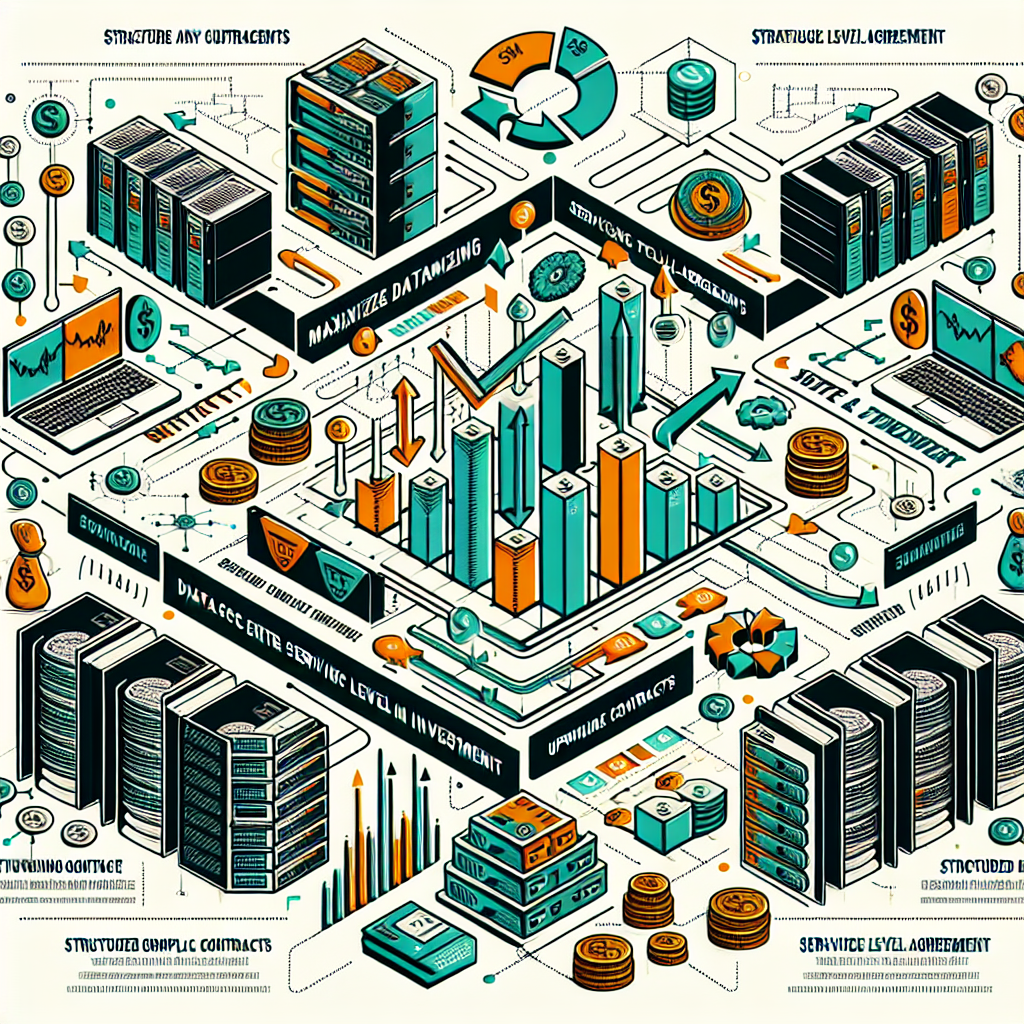Your cart is currently empty!
Tag: Data Center Service Level Agreements (SLAs)

Negotiating Data Center Service Level Agreements: Tips for Success
In today’s digital age, data centers play a crucial role in the smooth operation of businesses. They house and manage the critical IT infrastructure that supports an organization’s operations, making them a vital component of modern business operations. However, ensuring that data centers meet the needs of the organization requires clear and well-defined Service Level Agreements (SLAs). Negotiating these agreements can be a complex process, but with the right approach, organizations can set themselves up for success.Here are some tips for negotiating data center SLAs:
1. Define your requirements: Before entering into negotiations with a data center provider, it’s essential to clearly define your organization’s specific requirements. This includes understanding your current and future IT needs, as well as any regulatory or compliance requirements that may impact your data center services. By having a clear understanding of your needs, you can better negotiate SLAs that align with your business objectives.
2. Establish clear expectations: When negotiating SLAs, it’s crucial to establish clear expectations regarding the level of service that the data center provider will deliver. This includes defining key performance indicators (KPIs) such as uptime, response times, and resolution times. By setting clear expectations upfront, you can avoid misunderstandings and ensure that both parties are on the same page.
3. Consider scalability and flexibility: In today’s fast-paced business environment, organizations need data center services that can scale to meet their changing needs. When negotiating SLAs, it’s important to consider scalability and flexibility. This includes ensuring that the SLA allows for adjustments to service levels as your business grows or changes.
4. Include penalties for non-compliance: To ensure that the data center provider meets its obligations, it’s important to include penalties for non-compliance in the SLA. This can include financial penalties or service credits for downtime or performance issues. By including penalties for non-compliance, you can incentivize the data center provider to meet its commitments and protect your organization from potential disruptions.
5. Review and revise regularly: Once the SLA is in place, it’s important to regularly review and revise it to ensure that it continues to meet your organization’s needs. This includes conducting regular performance reviews, addressing any issues that arise, and making adjustments as needed. By regularly reviewing and revising the SLA, you can ensure that your data center services continue to meet your organization’s evolving needs.
In conclusion, negotiating data center SLAs requires careful planning and attention to detail. By following these tips, organizations can set themselves up for success and ensure that their data center services meet their business objectives. By defining requirements, establishing clear expectations, considering scalability and flexibility, including penalties for non-compliance, and regularly reviewing and revising the SLA, organizations can negotiate data center SLAs that support their business operations and help them achieve their goals.

Maximizing the Benefits of Data Center SLAs: Best Practices for Businesses
In today’s technology-driven world, data centers play a crucial role in the operations of businesses of all sizes. These facilities house and manage the data and information that are essential for the day-to-day functioning of companies. To ensure the smooth and efficient operation of data centers, service level agreements (SLAs) are put in place between data center providers and their clients. These SLAs outline the level of service that the provider will deliver and the responsibilities of both parties.Maximizing the benefits of data center SLAs is essential for businesses to ensure that they are getting the most out of their investment in data center services. Here are some best practices that businesses can follow to make the most of their data center SLAs:
1. Clearly define expectations: Before signing an SLA with a data center provider, it is crucial for businesses to clearly define their expectations and requirements. This includes specifying the level of uptime, response times, and security measures that are needed for the business to operate effectively.
2. Understand the SLA terms: It is important for businesses to thoroughly review and understand the terms of the SLA before signing it. This includes understanding the service levels that are guaranteed by the provider, as well as any penalties or remedies that are outlined in the agreement.
3. Monitor performance: Businesses should regularly monitor the performance of the data center provider to ensure that they are meeting the terms of the SLA. This includes tracking uptime, response times, and any other key performance indicators that are outlined in the agreement.
4. Communicate effectively: Communication is key to maximizing the benefits of data center SLAs. Businesses should maintain open lines of communication with their data center provider to address any issues or concerns that may arise. This includes providing feedback on the performance of the provider and working together to resolve any issues that may impact the quality of service.
5. Regularly review and update the SLA: As business needs and technology evolve, it is important to regularly review and update the SLA to ensure that it remains relevant and meets the needs of the business. This includes revisiting the terms of the agreement, updating service levels, and negotiating any changes that may be necessary to improve the quality of service.
By following these best practices, businesses can maximize the benefits of their data center SLAs and ensure that they are getting the most out of their investment in data center services. Effective management of SLAs can help businesses improve their operational efficiency, reduce downtime, and ensure the security of their data and information. Ultimately, a well-managed data center SLA can help businesses stay competitive in today’s fast-paced and technology-driven business environment.

Choosing the Right Data Center Service Level Agreement for Your Organization
In today’s digital age, data is at the heart of every organization. From customer information to financial records, businesses rely on data to make informed decisions and drive growth. With the increasing amount of data being generated and stored, it has become crucial for organizations to have a reliable data center service in place.One key aspect of a data center service is the Service Level Agreement (SLA). An SLA is a contract between a service provider and a customer that outlines the level of service that will be provided. It is essential for organizations to choose the right SLA for their data center service to ensure that their data is secure, accessible, and reliable.
When selecting an SLA for your organization’s data center service, there are several factors to consider. First and foremost, you should assess your organization’s needs and requirements. Consider the type and amount of data that your organization generates and stores, as well as any regulatory requirements that you need to comply with.
Next, evaluate the service provider’s track record and reputation. Look for a provider that has a proven track record of reliability and security. Check for any certifications or accreditations that the provider may have, such as ISO 27001 or SOC 2 compliance.
It is also important to consider the level of uptime that the SLA guarantees. Uptime is the amount of time that a system is operational and accessible. Look for an SLA that guarantees a high level of uptime, such as 99.99% or higher. This will ensure that your data is always available when you need it.
In addition to uptime, consider the provider’s disaster recovery and backup processes. Ensure that the SLA includes provisions for data backup and recovery in the event of a disaster or system failure. This will help ensure that your data is protected and accessible at all times.
Finally, consider the cost of the SLA. While it may be tempting to choose the cheapest option, it is important to weigh the cost against the level of service and reliability that the SLA provides. Remember that investing in a reliable data center service with a strong SLA is crucial to protecting your organization’s data and ensuring its continued success.
In conclusion, choosing the right SLA for your organization’s data center service is essential to ensuring the security, accessibility, and reliability of your data. Take the time to assess your organization’s needs, evaluate the service provider’s track record, and consider factors such as uptime, disaster recovery, and cost. By selecting a strong SLA, you can rest assured that your data is in safe hands and focus on driving your organization’s growth and success.

Leveraging Data Center SLAs for Competitive Advantage
In today’s digital age, data centers play a crucial role in enabling businesses to operate efficiently and effectively. As businesses increasingly rely on data centers to store and process their valuable data, it is essential for organizations to ensure that their data center service level agreements (SLAs) are optimized to meet their specific needs and requirements.A data center SLA is a contract between a data center provider and a customer that outlines the terms and conditions of the services that will be provided. These agreements typically include metrics such as uptime, performance, and security standards that the data center must meet in order to ensure the smooth functioning of the customer’s operations.
By leveraging data center SLAs for competitive advantage, businesses can ensure that their data center provider is meeting their specific needs and expectations. This can help businesses to improve their overall operational efficiency, reduce downtime, and enhance the security of their data.
One of the key benefits of leveraging data center SLAs is the ability to hold data center providers accountable for meeting agreed-upon performance standards. By clearly defining the metrics that must be met in the SLA, businesses can ensure that their data center provider is delivering the level of service that they require. This can help to prevent costly downtime and ensure that critical data is always available when needed.
Additionally, leveraging data center SLAs can help businesses to identify areas for improvement and optimization within their data center operations. By regularly monitoring and evaluating the performance metrics outlined in the SLA, businesses can identify any areas where the data center provider may be falling short and work with them to address these issues. This can help businesses to continuously improve their data center operations and stay ahead of the competition.
Furthermore, data center SLAs can also help businesses to enhance the security of their data. By including security standards and protocols in the SLA, businesses can ensure that their data center provider is taking the necessary steps to protect their sensitive data from cyber threats and breaches. This can help businesses to build trust with their customers and demonstrate their commitment to data security.
In conclusion, leveraging data center SLAs for competitive advantage can help businesses to optimize their data center operations, improve performance, and enhance data security. By working closely with their data center provider to define and monitor key performance metrics, businesses can ensure that their data center operations are always meeting their specific needs and requirements. This can help businesses to stay ahead of the competition and drive success in today’s digital economy.

Comparing Different Data Center Service Level Agreement Models
Data centers are essential for businesses to store and manage their data efficiently. However, not all data centers are created equal, and it is important for businesses to choose the right service level agreement (SLA) model that best suits their needs. There are several different data center service level agreement models available, each offering varying levels of service and support.One of the most common data center service level agreement models is the basic SLA model. This model typically offers a standard level of service and support, including 24/7 monitoring, regular maintenance, and technical support. While this model is cost-effective and suitable for small businesses with minimal data storage needs, it may not provide the level of service and support required by larger businesses with more complex data storage requirements.
Another popular data center service level agreement model is the premium SLA model. This model offers a higher level of service and support, including advanced monitoring, proactive maintenance, and dedicated technical support. While this model may come at a higher cost, it is ideal for businesses with mission-critical data storage needs that require maximum uptime and reliability.
In addition to the basic and premium SLA models, there are also customized SLA models available that can be tailored to meet the specific needs of individual businesses. These customized SLA models may include additional services such as disaster recovery planning, data migration, and security audits. While these models may come at a higher cost, they provide businesses with the flexibility to choose the services and support that best meet their unique data storage requirements.
When comparing different data center service level agreement models, businesses should consider several factors, including the level of service and support provided, uptime guarantees, security measures, and pricing. It is important for businesses to carefully evaluate their data storage needs and choose a service level agreement model that aligns with their requirements and budget.
In conclusion, choosing the right data center service level agreement model is essential for businesses to ensure their data is stored and managed effectively. By comparing different SLA models and considering factors such as service level, support, and pricing, businesses can make an informed decision that meets their data storage needs and helps them achieve their business goals.

Maximizing ROI through Strategic Data Center Service Level Agreements
In today’s digital age, data centers play a crucial role in ensuring the smooth operation of businesses. With the increasing reliance on data and technology, organizations are constantly looking for ways to maximize their return on investment (ROI) when it comes to their data center services. One effective way to achieve this is through strategic data center service level agreements (SLAs).A service level agreement is a contract between a service provider and a customer that outlines the level of service that will be provided. This contract typically includes metrics such as uptime, response time, and performance guarantees. By establishing clear expectations and responsibilities, SLAs help ensure that both parties are on the same page and that the data center services are meeting the needs of the business.
When it comes to maximizing ROI through strategic SLAs, there are several key factors to consider. First and foremost, it is important to align the SLAs with the overall business goals and objectives. This means identifying the critical applications and services that the data center supports and setting performance metrics that are in line with the organization’s strategic priorities.
Additionally, it is essential to establish realistic and achievable SLA targets. Setting overly ambitious goals may lead to dissatisfaction and frustration, while setting targets that are too low may result in subpar performance. By working closely with the service provider to define realistic SLA targets, organizations can ensure that they are getting the best value for their investment.
Another important factor to consider when maximizing ROI through SLAs is the inclusion of penalties and incentives. Penalties for failing to meet SLA targets can help incentivize the service provider to deliver on their promises, while incentives for exceeding targets can encourage exceptional performance. By including these provisions in the SLA, organizations can ensure that their data center services are consistently meeting or exceeding expectations.
Finally, it is crucial to regularly monitor and evaluate the performance of the data center services against the SLA targets. By tracking key metrics and conducting regular reviews with the service provider, organizations can identify areas for improvement and make necessary adjustments to ensure that they are getting the most out of their investment.
In conclusion, maximizing ROI through strategic data center service level agreements is essential for organizations looking to optimize their data center services and ensure that they are meeting the needs of the business. By aligning SLAs with business goals, setting realistic targets, including penalties and incentives, and monitoring performance, organizations can effectively leverage their data center services to drive success and achieve a competitive advantage in today’s fast-paced digital landscape.

The Role of Data Center SLAs in Ensuring Business Continuity
In today’s digital age, data centers play a crucial role in ensuring the smooth functioning of businesses. They are responsible for storing and managing vast amounts of data that are essential for the day-to-day operations of organizations. However, as data centers become increasingly complex and critical to business operations, the need for Service Level Agreements (SLAs) has become more important than ever.SLAs are formal agreements between a data center provider and its clients that outline the level of service that will be provided. These agreements typically include metrics such as uptime, response times, and data security measures. By clearly defining the expectations and responsibilities of both parties, SLAs help to ensure that data center services are delivered consistently and reliably.
One of the key roles of SLAs in data centers is to ensure business continuity. In the event of a disruption or outage, businesses rely on their data center provider to quickly resolve the issue and minimize any impact on their operations. SLAs help to establish clear guidelines for how downtime will be managed, including communication protocols, escalation procedures, and recovery time objectives.
By setting specific targets for uptime and response times, SLAs provide businesses with a level of assurance that their data will be available when they need it. This is particularly important for organizations that operate in industries where downtime can have serious consequences, such as finance, healthcare, or e-commerce.
Furthermore, SLAs also play a crucial role in data center security. In today’s digital landscape, data breaches and cyber attacks are a constant threat to businesses. SLAs can include provisions for data encryption, access controls, and regular security audits to help protect sensitive information from unauthorized access.
Overall, the role of SLAs in data centers is to provide businesses with peace of mind that their critical data and operations are in safe hands. By establishing clear expectations and accountability, SLAs help to ensure that data center services are delivered consistently, securely, and with minimal disruptions. In an age where data is king, having a strong SLA in place is essential for maintaining business continuity and safeguarding valuable assets.

Measuring and Monitoring Data Center SLAs for Optimal Performance
Data centers are the backbone of modern businesses, serving as the central hub for storing, processing, and managing critical data and applications. To ensure optimal performance and reliability, data center service level agreements (SLAs) play a crucial role in setting expectations between the data center provider and the client.Measuring and monitoring data center SLAs is essential for both parties to ensure that the agreed-upon performance levels are being met. By tracking key metrics and performance indicators, organizations can proactively identify and address issues before they impact the business.
One of the most important metrics to monitor is uptime, which refers to the amount of time that a data center is operational and available for use. Data center SLAs typically guarantee a certain level of uptime, such as 99.99%, which equates to only around 5 minutes of downtime per year. Monitoring uptime can help organizations assess the reliability of their data center provider and ensure that they are meeting their SLA commitments.
Another critical metric to track is latency, which measures the time it takes for data to travel from the user to the data center and back. High latency can result in slow application performance and user dissatisfaction. Monitoring latency can help organizations identify potential bottlenecks in their network infrastructure and optimize performance to ensure a seamless user experience.
Bandwidth utilization is another key metric to monitor, as it measures the amount of data being transmitted through the network at any given time. Monitoring bandwidth utilization can help organizations identify potential issues with network congestion and plan for future capacity upgrades to ensure optimal performance.
In addition to these key metrics, organizations should also monitor other performance indicators such as power usage, cooling efficiency, and security compliance to ensure that their data center is operating at peak performance.
To effectively measure and monitor data center SLAs, organizations can leverage monitoring tools and software that provide real-time visibility into key performance metrics. These tools can help organizations track SLA compliance, identify potential issues, and optimize performance to maximize the value of their data center investment.
In conclusion, measuring and monitoring data center SLAs is essential for ensuring optimal performance and reliability. By tracking key performance metrics such as uptime, latency, and bandwidth utilization, organizations can proactively identify and address issues to ensure that their data center is operating at peak performance. Leveraging monitoring tools and software can help organizations maximize the value of their data center investment and ensure that they are meeting their SLA commitments.

Ensuring Compliance with Data Center SLAs: Best Practices
Data centers are the backbone of modern businesses, providing the infrastructure necessary to store and manage vast amounts of data. With the increasing reliance on data centers, organizations are entering into service level agreements (SLAs) with their data center providers to ensure that their data is secure and accessible at all times. However, ensuring compliance with these SLAs can be a challenging task.To help organizations meet their SLAs and maintain a high level of data center performance, there are several best practices that can be implemented. These practices include:
1. Clearly define SLA requirements: Before entering into an SLA with a data center provider, it is important to clearly outline the specific requirements and expectations for data center performance. This includes defining uptime guarantees, response times for issue resolution, and data recovery procedures in the event of a disaster.
2. Regular monitoring and reporting: Monitoring the performance of the data center is essential to ensure compliance with SLAs. This includes tracking key performance metrics such as uptime, latency, and bandwidth utilization. Regular reporting on these metrics can help identify potential issues before they impact data center performance.
3. Implementing redundancy and failover mechanisms: To ensure high availability of data, organizations should implement redundancy and failover mechanisms in their data center infrastructure. This includes deploying backup power systems, redundant networking equipment, and data replication across multiple locations.
4. Conducting regular audits and assessments: Regular audits and assessments of the data center infrastructure can help identify potential vulnerabilities and areas for improvement. This includes conducting security audits, performance assessments, and compliance checks to ensure that the data center is meeting SLA requirements.
5. Establishing a communication plan: In the event of a data center outage or performance issue, it is important to have a communication plan in place to keep stakeholders informed. This includes establishing communication channels with the data center provider, internal teams, and customers to provide updates on the status of the issue and expected resolution timelines.
By implementing these best practices, organizations can ensure compliance with data center SLAs and maintain a high level of data center performance. This not only helps protect critical business data but also strengthens the relationship between organizations and their data center providers. Ultimately, ensuring compliance with data center SLAs is essential for maintaining business continuity and meeting the needs of customers in today’s data-driven world.

Evaluating and Improving Data Center Service Level Agreements (SLAs) Performance
Data centers are the backbone of modern businesses, providing the necessary infrastructure to support critical IT operations. To ensure the smooth functioning of data centers, service level agreements (SLAs) are put in place to define the level of service that is expected from the data center provider. However, evaluating and improving data center SLA performance is crucial to ensure that businesses are receiving the level of service they require.One of the key factors in evaluating data center SLA performance is to clearly define the metrics that will be used to measure performance. These metrics can include uptime, response times, and resolution times for any issues that arise. By clearly defining these metrics, businesses can effectively evaluate whether the data center provider is meeting the agreed-upon service levels.
Another important aspect of evaluating data center SLA performance is to conduct regular reviews of the SLA with the data center provider. This can help to identify any areas where performance may be lacking and provide an opportunity to make improvements. It is also important to communicate any changes or updates to the SLA with all relevant stakeholders to ensure that everyone is on the same page.
In addition to evaluating data center SLA performance, businesses should also look for ways to improve performance and ensure that they are getting the most out of their data center provider. This can include implementing monitoring tools to track performance metrics in real-time, conducting regular performance audits, and working closely with the data center provider to address any issues that may arise.
By evaluating and improving data center SLA performance, businesses can ensure that they are receiving the level of service they require to support their critical IT operations. This can help to minimize downtime, improve efficiency, and ultimately, support the overall success of the business.
